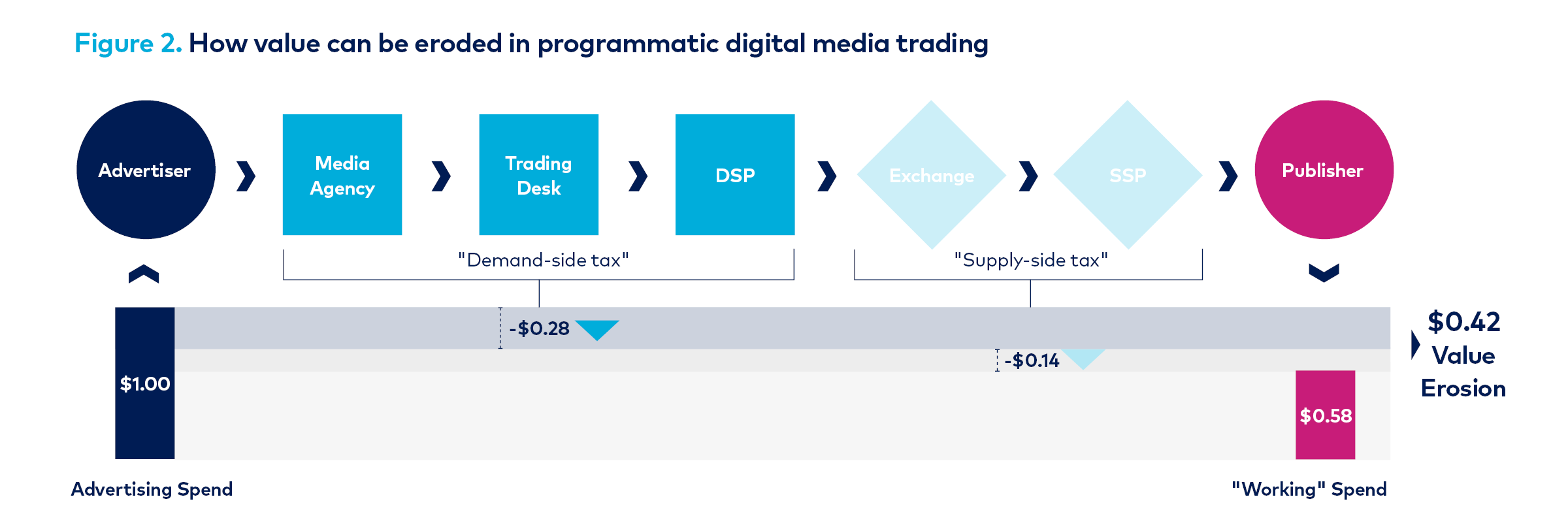The changing media ecosystem
More than half of all advertising today is digital, and almost 90% of digital display ads are traded programmatically. With its roots in the first ad servers – set up in the mid-1990s to sell banner advertising, followed by the birth of the ad networks a few years later – programmatic has risen to dominance in the course of the past decade.
An increasingly large proportion of other media is being traded programmatically, too, as traditional media digitise, including addressable TV and digital out-of-home. There’s a good chance that current disruption to media markets resulting from COVID-19 will accelerate these trends.
The overly-complex programmatic marketplace
Nevertheless, the programmatic digital media supply chain is incredibly – and often unnecessarily – complex. In certain areas, it has become this way almost by design. The ecosystem involves multiple links between advertisers and publishers, including: media agencies, trading desks, demand- and supply-side platforms; ad servers, ad networks, and ad exchanges; ad verification and data management platforms.
Each agency or technology business in the chain takes a slice of the advertiser’s budget, however small. Studies have shown that this leads to value erosion between advertisers and publishers, typically 40c in the dollar and as high at 85c in the dollar (see Figure 1).
And that’s before you start to factor in the impact on ROI of diverse issues such as non-human traffic, ad fraud, brand safety and viewability. “Non-working” media costs have ballooned at the expense of budget available for media inventory. That’s why one of the more popular and colourful metaphors used to describe programmatic media buying is “the leaky bucket”.

Addressing the challenges
It’s little wonder that many marketers struggle to understand how programmatic works, let alone appreciate the potential value that all of the links in the chain can add and subtract.
Optimising the return on investment that programmatic can deliver comes from knowledge and experience of the market. The key to unlocking value in programmatic ecosystems is for brands to build a detailed understanding of how it works. Central to building this understanding is a willingness to ask questions of your agency and technology partners until you’re satisfied with their answers.
While getting to grips with programmatic may seem like a daunting task, it is perfectly possible for advertisers to demystify the programmatic ecosystem as it relates to them, and, in the process, improve return on investment. This is best achieved by navigating through the different aspects of it logically, step-by-step.
The three key areas where advertisers need to focus attention are:
• Mapping the supply chain
• Managing relationships and contracts
• Taking control and ownership of data
Top tips for mapping the supply chain
• Ask your agency partners for a comprehensive breakdown of your media supply chain – what each link in the chain does, how much it costs, and what value it adds.
• Determine how many ad exchanges are included in the transactional chain, why they’ve been included, what each of them adds to your buy, and if there’s an opportunity to rationalise and remove some.
• Assess whether you wouldn’t in fact be better off striking direct deals with publishers, cutting out middlemen.
Top tips managing relationships and contracts
• Ask your colleagues in legal and procurement to work with you to review and – if necessary – renegotiate the terms of your contract.
• Review the contract with your media agency of record at least annually to ensure it’s fit-for-purpose. Make sure it includes rights to audit and that you exercise those rights. Be sure all relevant parties sign the contract, including all affiliate and subsidiary companies in your programmatic media supply chain.
• Set objectives, and targets, up front. Review performance, and make sure that your agency is optimising.
Top tips for taking ownership and control of data
• Ask how and why buying audience data is enriching media spend. Ask if it’s possible to achieve the same (or better) business outcomes without data, by using a broad audience, or by making contextual buys.
• Make extensive use of A/B testing to learn what works for you and what doesn’t. Run tests on enriched data vs contextual placements, enriched data vs direct buys.
• Make sure you know what consequences your briefing will result in. Be aware that a brief to deliver cheap CPMs will almost inevitably compromise quality, brand safety, viewability, and return on investment.
In summary
With the programmatic genie out of the bottle, no-one’s arguing for turning back the clock. But the complexity of the ecosystem has meant that some advertisers now accept the status quo without fully realising the cost and value of their programmatic investments.
Armed with the right questions, we believe that it is possible to drive value through programmatic media, but to do so takes an informed and holistic approach. Brands should begin by building their understanding – with the help of their media agencies, ad tech partners, and independent advisors – of how their programmatic supply chain works.
Our experience and that of many of our clients shows that this approach leads brands down a path that could result in significant improvements to the effectiveness and efficiency of their programmatic digital media investments.
Download the full Ebiquity guide, Fixing the leaky bucket: How to optimise value from programmatic media buying, here.
This article was featured in WARC.

